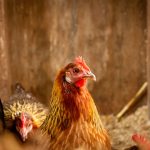Chickens are resilient animals, but they can be affected by cold temperatures, particularly during winter. Understanding the specific requirements of chickens is crucial for providing optimal care in colder seasons. Chickens thrive in temperatures between 45-85 degrees Fahrenheit, making proper insulation and heating of their coop essential for maintaining their warmth and health.
Different chicken breeds may have varying levels of cold tolerance, so it’s important to consider the specific needs of your flock when preparing for winter. In addition to temperature management, it’s vital to understand chicken behavior in cold weather. Chickens often huddle together to conserve body heat, necessitating adequate space for comfortable grouping.
Constant access to fresh water is crucial, as dehydration can be a significant concern in cold conditions. A thorough understanding of chicken needs enables informed decision-making regarding their care during winter months.
Table of Contents
- 1 Providing proper insulation for the coop
- 2 Using heat lamps or heaters
- 3 Ensuring good ventilation
- 4 Providing enough bedding
- 5 Offering supplemental heat sources
- 6 Monitoring the temperature regularly
- 7 FAQs
- 7.1 What are the best ways to keep chickens warm at night?
- 7.2 How can I insulate my chicken coop to keep it warm at night?
- 7.3 Is it safe to use heat lamps or heated pads for chickens?
- 7.4 What temperature should the chicken coop be at night?
- 7.5 How can I ensure good ventilation in the chicken coop while keeping it warm?
Key Takeaways
- Understanding the needs of your chickens is crucial for providing proper care and ensuring their well-being.
- Proper insulation for the coop is essential to protect chickens from extreme temperatures and maintain a comfortable environment.
- Heat lamps or heaters can be used to provide additional warmth during cold weather, but they should be used with caution to prevent fire hazards.
- Good ventilation is important for regulating humidity and preventing the buildup of harmful gases in the coop.
- Providing enough bedding, such as straw or wood shavings, helps to insulate the coop and keep chickens warm.
- Offering supplemental heat sources, such as heated perches or radiant heaters, can help chickens stay warm without the use of heat lamps.
- Monitoring the temperature regularly is necessary to ensure that the coop remains at a comfortable and safe level for the chickens.
Providing proper insulation for the coop
Methods of Insulation
There are several ways to insulate a chicken coop, including adding extra layers of wood or plastic to the walls, using insulation panels, or even using straw bales to create a barrier against the cold.
Insulating All Sides of the Coop
It’s crucial to ensure that the coop is well-insulated on all sides, including the roof, to prevent heat from escaping and cold air from entering. In addition to insulating the walls and roof, it’s essential to insulate the floor of the coop as well. This can be done by adding a layer of straw or wood shavings to create a barrier between the ground and the coop floor.
The Importance of Proper Insulation
Proper insulation is vital for the health and comfort of your chickens. It helps to keep the coop warmer and drier, which is essential for their well-being. By insulating your chicken coop, you can ensure that your flock stays warm and healthy throughout the winter months.
Using heat lamps or heaters

Heat lamps or heaters can be a valuable tool for keeping your chicken coop warm during the winter months. These devices provide a source of heat that can help to maintain a comfortable temperature inside the coop, even when the weather outside is cold and snowy. There are several different types of heat lamps and heaters available, including infrared heat lamps, ceramic heaters, and radiant heaters.
It’s important to choose a heat source that is safe for use in a chicken coop and to follow all manufacturer recommendations for installation and operation. When using heat lamps or heaters in a chicken coop, it’s important to place them in a safe location where they cannot come into contact with flammable materials or be knocked over by curious chickens. It’s also important to monitor the temperature inside the coop regularly to ensure that it remains within a comfortable range for your flock.
Heat lamps or heaters can be a valuable tool for keeping your chickens warm during the winter months, but it’s important to use them safely and responsibly.
Ensuring good ventilation
While it may seem counterintuitive, good ventilation is essential for keeping a chicken coop warm during the winter months. Proper ventilation helps to remove excess moisture from the air, which can lead to dampness and mold inside the coop. It also helps to prevent the buildup of ammonia from chicken droppings, which can be harmful to the respiratory health of your flock.
Good ventilation also helps to regulate the temperature inside the coop, preventing it from becoming too hot or too cold. There are several ways to ensure good ventilation in a chicken coop, including adding vents or windows that can be opened and closed as needed. It’s important to strike a balance between allowing fresh air to enter the coop and preventing drafts that can make it too cold for your chickens.
Monitoring the airflow inside the coop regularly can help you determine if any adjustments need to be made to ensure good ventilation. Good ventilation is essential for maintaining a healthy and comfortable environment for your flock during the winter months.
Providing enough bedding
Bedding is an important component of keeping a chicken coop warm during the winter months. The right bedding can help to insulate the floor of the coop, keeping it warmer and drier for your flock. There are several different types of bedding that can be used in a chicken coop, including straw, wood shavings, and shredded paper.
It’s important to choose a bedding material that is absorbent and provides good insulation against the cold. In addition to providing enough bedding on the floor of the coop, it’s important to regularly clean and replace soiled bedding to prevent the buildup of moisture and ammonia. This will help to keep the coop dry and comfortable for your chickens, reducing the risk of respiratory issues and other health problems.
Providing enough clean, dry bedding is an essential part of preparing your chicken coop for the winter months and will help to keep your flock warm and healthy.
Offering supplemental heat sources

Supplemental Heat Sources for a Cozy Coop
In addition to insulation and proper ventilation, offering supplemental heat sources can help keep your chickens warm during the winter months. There are several options for supplemental heat sources, including heated perches, heated waterers, and heated pads or mats. These devices provide targeted warmth for your chickens, helping them stay comfortable even in cold weather.
Safety Precautions for Supplemental Heat Sources
It’s important to choose supplemental heat sources that are safe for use in a chicken coop and to follow all manufacturer recommendations for installation and operation. When using supplemental heat sources in a chicken coop, it’s important to monitor them regularly to ensure that they are functioning properly and not posing any safety risks.
Monitoring Temperature and Safety
It’s also important to monitor the temperature inside the coop regularly to ensure that it remains within a comfortable range for your flock. Offering supplemental heat sources can help keep your chickens warm and comfortable during the winter months, but it’s important to use them safely and responsibly.
Monitoring the temperature regularly
Monitoring the temperature inside the chicken coop regularly is essential for ensuring that your flock stays warm and healthy during the winter months. There are several different ways to monitor the temperature inside a chicken coop, including using a thermometer or a temperature-controlled alarm system. It’s important to check the temperature inside the coop at least once a day, especially during extreme cold weather, to ensure that it remains within a comfortable range for your flock.
In addition to monitoring the temperature inside the coop, it’s important to observe the behavior of your chickens for signs of discomfort or distress. If you notice that your chickens are huddling together more than usual or seem lethargic, it may be a sign that they are too cold. Making adjustments to the insulation, ventilation, or heating in the coop may be necessary to ensure that your flock stays warm and healthy.
Regularly monitoring the temperature inside the chicken coop and observing the behavior of your flock will help you make informed decisions about how best to care for them during the winter months. In conclusion, understanding the needs of your chickens and taking steps to provide proper insulation, heating, ventilation, bedding, and supplemental heat sources are essential for keeping your flock warm and healthy during the winter months. Regularly monitoring the temperature inside the coop and observing the behavior of your chickens will help you make informed decisions about how best to care for them during cold weather.
By taking these steps, you can ensure that your chickens stay warm and comfortable even when temperatures drop outside.
If you’re looking for more information on how to keep your chickens warm at night, you may also be interested in learning about the importance of providing a coop for your turkeys. Check out this article on Do Turkeys Need a Coop? to learn more about the housing needs of turkeys and how it relates to keeping them warm and safe.
FAQs
What are the best ways to keep chickens warm at night?
Some effective ways to keep chickens warm at night include providing a well-insulated coop, using heat lamps or heated pads, and ensuring good ventilation while blocking drafts.
How can I insulate my chicken coop to keep it warm at night?
Insulate the chicken coop by using materials such as straw, hay, or wood shavings on the floor, sealing any gaps or cracks, and adding insulation to the walls and ceiling.
Is it safe to use heat lamps or heated pads for chickens?
When used properly and with caution, heat lamps and heated pads can be safe for chickens. It’s important to follow manufacturer’s instructions, keep them away from flammable materials, and monitor them regularly.
What temperature should the chicken coop be at night?
The ideal temperature for a chicken coop at night is around 45-50 degrees Fahrenheit. It’s important to avoid extreme temperature fluctuations and provide a consistent, comfortable environment for the chickens.
How can I ensure good ventilation in the chicken coop while keeping it warm?
Good ventilation in the chicken coop can be achieved by installing vents near the ceiling, using windows with adjustable openings, and ensuring that the coop is not completely airtight. This allows for fresh air circulation while preventing drafts.
Meet Walter, the feathered-friend fanatic of Florida! Nestled in the sunshine state, Walter struts through life with his feathered companions, clucking his way to happiness. With a coop that’s fancier than a five-star hotel, he’s the Don Juan of the chicken world. When he’s not teaching his hens to do the cha-cha, you’ll find him in a heated debate with his prized rooster, Sir Clucks-a-Lot. Walter’s poultry passion is no yolk; he’s the sunny-side-up guy you never knew you needed in your flock of friends!







